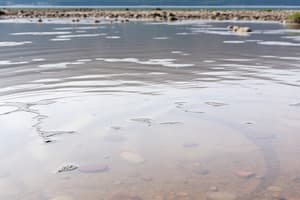Podcast
Questions and Answers
What is the primary consequence of introducing non-water substances into water bodies?
What is the primary consequence of introducing non-water substances into water bodies?
- Pollution only affects aquatic organisms
- Pollution only affects the water's original composition
- Pollution only occurs in air and soil
- Water bodies become useless for human use and essential activities (correct)
What is the purpose of chemical analysis of small water samples and aquatic organisms?
What is the purpose of chemical analysis of small water samples and aquatic organisms?
- To determine the status of water quality (correct)
- To categorize water pollutants
- To identify point sources of pollution
- To identify the origin of pollution
What type of pollution occurs when an oil spill happens near a platform?
What type of pollution occurs when an oil spill happens near a platform?
- Point Source pollution (correct)
- Air pollution
- Soil pollution
- Non-Point Source pollution
What are the main pollutants of water according to the text?
What are the main pollutants of water according to the text?
Why is water pollution often invisible?
Why is water pollution often invisible?
What is a major concern when using polluted water in agriculture?
What is a major concern when using polluted water in agriculture?
Why is groundwater pollution more difficult to detect than surface water pollution?
Why is groundwater pollution more difficult to detect than surface water pollution?
What is the main difference between direct and diffuse pollution of groundwater?
What is the main difference between direct and diffuse pollution of groundwater?
What is a characteristic of groundwater that makes it difficult to prevent or eliminate contamination?
What is a characteristic of groundwater that makes it difficult to prevent or eliminate contamination?
What is a unique risk associated with surface water pollution that is not associated with groundwater pollution?
What is a unique risk associated with surface water pollution that is not associated with groundwater pollution?
What is the primary way to classify the sources of water pollution?
What is the primary way to classify the sources of water pollution?
What is an example of natural pollution?
What is an example of natural pollution?
What is a consequence of eutrophication in a water body?
What is a consequence of eutrophication in a water body?
What is a result of surface water pollution that affects humans?
What is a result of surface water pollution that affects humans?
What is the state of the environment in its natural state?
What is the state of the environment in its natural state?
What can contaminated water bodies become due to pollution?
What can contaminated water bodies become due to pollution?
What is the purpose of identifying the sources of water pollution?
What is the purpose of identifying the sources of water pollution?
What is characteristic of non-point sources of water pollution?
What is characteristic of non-point sources of water pollution?
What can be used to determine the status of water quality?
What can be used to determine the status of water quality?
What is the main reason why groundwater pollution is difficult to fix?
What is the main reason why groundwater pollution is difficult to fix?
What is a factor that affects the level of contamination of groundwater?
What is a factor that affects the level of contamination of groundwater?
What is a source of direct pollution of groundwater?
What is a source of direct pollution of groundwater?
What is the primary source of water for human activities?
What is the primary source of water for human activities?
Why is groundwater pollution a concern for all forms of life?
Why is groundwater pollution a concern for all forms of life?
How does the terrain affect the movement of groundwater?
How does the terrain affect the movement of groundwater?
What is the result of the decomposition of an animal's corpse in a body of water?
What is the result of the decomposition of an animal's corpse in a body of water?
What is the effect of rainwater runoff on surface water bodies?
What is the effect of rainwater runoff on surface water bodies?
What is the purpose of testing water samples for fecal coliform bacteria?
What is the purpose of testing water samples for fecal coliform bacteria?
Why is it difficult to use polluted water for human activities?
Why is it difficult to use polluted water for human activities?
Flashcards are hidden until you start studying
Study Notes
Water Pollution Definition
- Water pollution occurs when non-water substances are introduced into water, causing potential imbalance and damage to the environment.
- Polluted water is unusable for drinking, human use, irrigation, and livestock.
- Main water pollutants include bacteria, viruses, parasites, fertilizers, pesticides, pharmaceutical products, nitrates, phosphates, plastics, fecal waste, and radioactive substances.
Sources of Water Pollution
- Sources of pollution can be categorized into two: point sources and non-point sources.
- Point sources: pollution occurs from a single, identifiable source (e.g., oil spill, pipe discharging wastewater).
- Non-point sources: pollution occurs over a wide area with many possible sources (e.g., town, industries, agricultural area).
Classification of Water Pollution
- Water pollution can be classified into two categories: natural and anthropogenic.
- Natural pollution: caused by natural phenomena or natural processes (e.g., animal decomposition, volcanic eruption).
- Anthropogenic pollution: caused by human activities (e.g., hospital wastewater, industrial waste).
Types of Water Pollution
- Water pollution can be classified into surface water pollution and groundwater pollution.
- Surface water pollution: alteration of surface water bodies through harmful substances (e.g., rivers, lakes, seas).
- Groundwater pollution: introduction of substances that alter the original composition of groundwater.
Surface Water Pollution
- Surface water pollution is easier to detect and remedy due to accessibility.
- Anthropogenic sources of surface water pollution include domestic wastewater, industry wastewater, livestock wastewater, and agricultural wastewater.
- Pollutants in surface water include organic matter, pathogens, heavy metals, pharmaceuticals, hydrocarbons, and nutrients.
- Effects of surface water pollution include a decrease in dissolved oxygen, increased turbidity, sedimentation, eutrophication, and expansion of pathogen bacteria.
Groundwater Pollution
- Groundwater pollution is more difficult to detect and remedy due to inaccessibility.
- Groundwater pollution can be direct or diffuse, depending on the characteristics of the terrain.
- Characteristics of groundwater pollution include diverse origin and distribution of pollutants, localized or widespread contamination, and slow movement of groundwater.
- Risks of groundwater pollution are similar to those of surface water, except for eutrophication.
Water Pollution Definition
- Water pollution occurs when non-water substances are introduced into water, causing potential imbalance and damage to the environment.
- Polluted water is unusable for drinking, human use, irrigation, and livestock.
- Main water pollutants include bacteria, viruses, parasites, fertilizers, pesticides, pharmaceutical products, nitrates, phosphates, plastics, fecal waste, and radioactive substances.
Sources of Water Pollution
- Sources of pollution can be categorized into two: point sources and non-point sources.
- Point sources: pollution occurs from a single, identifiable source (e.g., oil spill, pipe discharging wastewater).
- Non-point sources: pollution occurs over a wide area with many possible sources (e.g., town, industries, agricultural area).
Classification of Water Pollution
- Water pollution can be classified into two categories: natural and anthropogenic.
- Natural pollution: caused by natural phenomena or natural processes (e.g., animal decomposition, volcanic eruption).
- Anthropogenic pollution: caused by human activities (e.g., hospital wastewater, industrial waste).
Types of Water Pollution
- Water pollution can be classified into surface water pollution and groundwater pollution.
- Surface water pollution: alteration of surface water bodies through harmful substances (e.g., rivers, lakes, seas).
- Groundwater pollution: introduction of substances that alter the original composition of groundwater.
Surface Water Pollution
- Surface water pollution is easier to detect and remedy due to accessibility.
- Anthropogenic sources of surface water pollution include domestic wastewater, industry wastewater, livestock wastewater, and agricultural wastewater.
- Pollutants in surface water include organic matter, pathogens, heavy metals, pharmaceuticals, hydrocarbons, and nutrients.
- Effects of surface water pollution include a decrease in dissolved oxygen, increased turbidity, sedimentation, eutrophication, and expansion of pathogen bacteria.
Groundwater Pollution
- Groundwater pollution is more difficult to detect and remedy due to inaccessibility.
- Groundwater pollution can be direct or diffuse, depending on the characteristics of the terrain.
- Characteristics of groundwater pollution include diverse origin and distribution of pollutants, localized or widespread contamination, and slow movement of groundwater.
- Risks of groundwater pollution are similar to those of surface water, except for eutrophication.
Studying That Suits You
Use AI to generate personalized quizzes and flashcards to suit your learning preferences.




